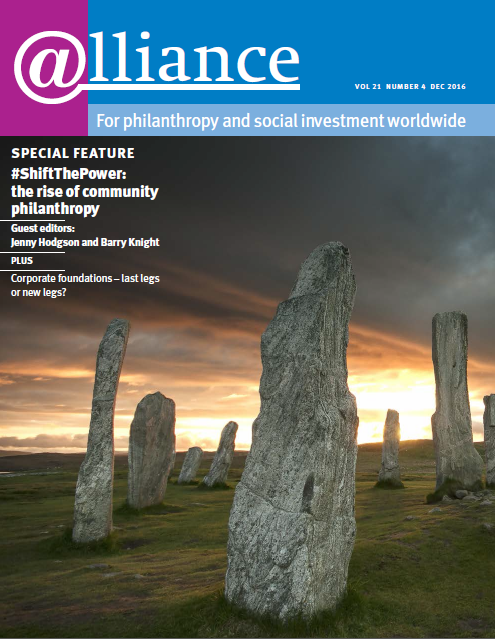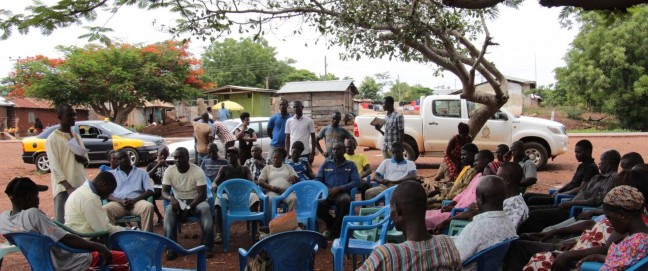On the shelf of philanthropic playthings, community philanthropy sits like a teddy bear. Next to the die-cast action figures of scientific and venture philanthropy, it feels soft, flexible and comforting; compared to the precious and fragile porcelain dolls of antique philanthropy, it feels sturdy and huggable. However, as anybody who has seen Toy Story 3 will know, the cuddly image of a teddy bear can be deceptive. Thus, when community philanthropy evokes images of equality, equity and inclusiveness, how far do these reflect reality?
 Notwithstanding the definitional challenges surrounding community philanthropy, there is an overarching feeling that it encourages equality. It moves philanthropy from a top-down perspective towards a horizontal, inclusive and reciprocal approach; it mobilizes a community’s own resources to promote, build, empower and improve that community. That an emphasis on horizontal and reciprocal philanthropy necessarily leads to more equality seems, however, to be an overly romanticized perspective.
Notwithstanding the definitional challenges surrounding community philanthropy, there is an overarching feeling that it encourages equality. It moves philanthropy from a top-down perspective towards a horizontal, inclusive and reciprocal approach; it mobilizes a community’s own resources to promote, build, empower and improve that community. That an emphasis on horizontal and reciprocal philanthropy necessarily leads to more equality seems, however, to be an overly romanticized perspective.
While equality focuses on similarity and sameness, equity stresses fairness and the appropriateness of provisions and opportunities.
As Feierman’s Reciprocity and Assistance in Precolonial Africa shows, reciprocity, caring and community frequently sit alongside dominance and the maintaining and reinforcing of inequalities. Similarly, Layton[1], examining practices of community philanthropy in different countries, questions the extent to which those practices actually differ from more traditional philanthropy: in the end, both appear to entrench established social relations.
While its relationship with equality is tenuous, and with equity uncertain, there is little doubt that community philanthropy can address another important issue: inclusiveness.
If equality is not the forte of community philanthropy, what about equity? Not only is the idea gaining prominence and traction in the philanthropy field, but its pursuit is considered a central tenet of community philanthropy. While equality focuses on similarity and sameness, equity stresses fairness and the appropriateness of provisions and opportunities. The former is thus relatively mechanistic, the latter contextual and subjective. As such, it is hard to assess.
Studies of community philanthropy that directly refer to equity, like Kuljian’s Philanthropy and Equity: The case of South Africa, point to a paucity of research and to the need for a more robust evidence base. They also highlight the challenges of equity within traditional organizational forms of community philanthropy, such as community foundations. Their US expressions, in particular, seem to have overemphasized endowment building. Thus, their potential for addressing equity issues has not necessarily been fulfilled.
While its relationship with equality is tenuous, and with equity uncertain, there is little doubt that community philanthropy can address another important issue: inclusiveness. Recent work combining relative deprivation research, social psychology and legal studies highlights the importance of procedural justice in allocating resources: the process on which a decision or outcome is based is often considered to be as important as the end result.[2]
As part of this, opportunities for participation and ‘voice’, the feeling of empowerment, establishing trust through personal knowledge, and mutual treatment with dignity and respect have been identified as important contributors. Obviously, there are caveats in applying these ideas to community philanthropy. Process and substance should not be conflated. Furthermore, there are ongoing debates about the relative importance and practical implementation of these elements. However, it is easy to see how the more inclusive and broader casting of community philanthropy can start to address these issues more easily, and potentially more effectively, than its siblings on the philanthropy shelf.
Tobias Jung is director of the Centre for the Study of Philanthropy & Public Good at the School of Management, University of St Andrews. Email tj3@st-andrews.ac.uk
Footnotes
- ^ M D Layton (2016) ‘Philanthropy at the community level. Supporting community empowerment’, in The Routledge Companion to Philanthropy.
- ^ Dolan et al (2007) ‘It ain’t what you do, it’s the way that you do it: Characteristics of procedural justice and their importance in social decision-making.’ Journal of Economic Behavior & Organization 64(1): 157-170.




Comments (0)